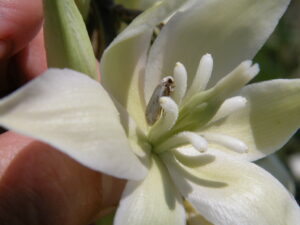By Hannah Hunt
“Save the Bees” is a concept we are all familiar with—honey bees make it possible for the grocery store to be stocked with the fruit and veggies we love. However, many other species are working behind the scenes as pollinators– some even more effective than the honey bee – to pollinate our gardens, trees, and wildflower meadows.
Meet the Night Crew:
 Bats are not big-time pollinators in Kentucky, but world-wide over 500 plant species rely on bats to pollinate their flowers, including species of mango, banana, durian, guava and agave.
Bats are not big-time pollinators in Kentucky, but world-wide over 500 plant species rely on bats to pollinate their flowers, including species of mango, banana, durian, guava and agave.

Moths are better at pollinating than previously thought, thanks to their hairy underbellies, a recent study from College University London suggests. Declines in moth populations, combined with a growing understanding of their importance for pollination, highlight the need to include these nocturnal pollinators in pollinator conservation efforts.

Beetles make up the largest group of pollinating animals because of their large numbers and are the most diverse group of pollinators in the U.S. Fossil records show that beetles were abundant during the Mesozoic Era – about 200 million years ago, also known as the reptile age. Beetles were the primary pollinators of flowering tree species like magnolia. Magnolias are considered a primitive woody species rooted in ancient evolutionary origins (U.S. Forest Service).
Both day- and night-active pollinators face many threats, including habitat loss, pesticide exposure, disease, and invasive species. But one hazard unique to nocturnal pollinators is light pollution. Artificial lights disorient moths, and research has found this can impair finding mates, evading predators, and pollinating plants. A recent study found that nocturnal visits to plants was reduced by 62 percent in areas with artificial illumination compared to dark areas (Nature, 2017). Bernheim takes part in the Dark Skies Movement, a campaign to reduce light pollution to improve the well-being, health, and safety of both people and wildlife.

